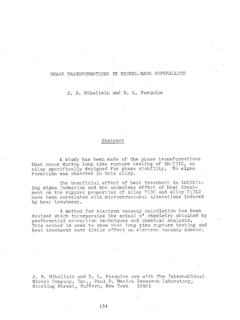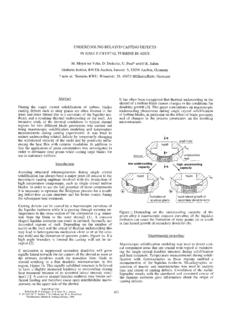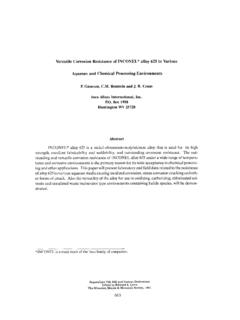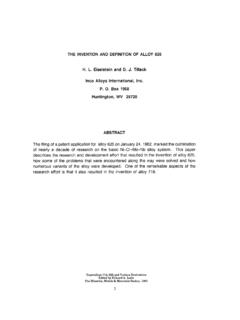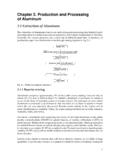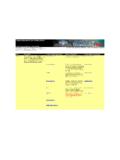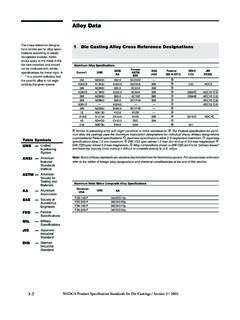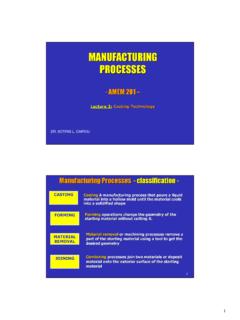Transcription of Thermal Fatigue Resistance of Alloy 718 for Aluminum Die ...
1 Thermal Fatigue Resistance OF Alloy 718 FOR Aluminum DIE casting DIES Michael M. Antony and John W. Smythe Allvac, an Allegheny Technologies Company 2020 Ashcraft Avenue Monroe, North Carolina 28 1 10 b Abstract Hot-work die steels have enjoyed extensive use as casting dies for over 70 years. casting dies are typically made of H-13 when the die temperature remains below about 800 F (427 C). When the die temperature exceeds 800 F (427"C), the selection of a die material must be made from a relatively limited range of high-strength maraging steels or modified H-13 alloys. The performance of Aluminum casting dies is particularly troublesome because the casting temperatures often exceed the capability of current die materials. As a result, dies invariably fail by Thermal Fatigue . Nickel-base superalloys have never received serious consideration as die materials because of high raw material costs and poor Thermal properties. The increased awareness of die life makes alloys, such as 718, attractive from a life-cycle cost point of view.
2 Recent investigations at Allvac, an Allegheny Technologies company, have shown that over a range of conditions, 7 18 offers significantly better Thermal Fatigue Resistance compared to H- 13. Further, 718 appears better able to tolerate high temperature exposures during Aluminum die casting . The excellent high temperature strength and oxidation Resistance of 718 cofibine for excellent Thermal Fatigue Resistance . Thermal Fatigue test results and microstructural evaluations of test specimens are summarized and discussed in this paper. Superalloys 718, 625, 706 and Various Derivatives Edited by Loria TMS (The Minerals, Metals R: Materials Society), 2001 Introduction Die castings are produced by injecting molten metal under pressure into the cavity of a metal mold or die. The cavity imparts shape to the solidifying metal. There are four principal Alloy systems which are commonly die cast. These include zinc, magnesium, Aluminum , and copper (brass), with approximate casting temperatures of 800 F (427"C), 1200 F (649"C), 1250 F (677"C), and 1780 F (971 C), respectively.
3 The performance of casting dies depends upon a number of factors, including casting temperature, geometry, and casting speed. In general, higher casting temperatures, greater cavity complexity, and higher casting speeds degrade casting die performance. The performance of Aluminum casting dies is particularly troublesome because the casting temperatures slightly exceed the capability of current die materials. Dies invariably fail by Thermal Fatigue or heat checking where small cracks develop on the die surface after repeated Thermal cycling. This is a major deficiency of current alloys. The casting die is generally produced by machining or forming a die block. Materials for casting dies must resist Thermal Fatigue , stress corrosion cracking, and softening at elevated temperatures. Thermal Fatigue leads to fine cracks on the die surface which can cause rejection of the casting . Stress corrosion cracking and corrosion Fatigue can lead to catastrophic failure of the die and in most cases, stress corrosion starts at water cooling lines (1).
4 Resistance to softening at elevated temperatures is necessary to prevent Thermal Fatigue as well as erosion during the injection of molten metal. casting dies are typically made of hot work tool steels when the die temperature remains below about 800 F. The most commonly used hot-work die steel is H-13 ( .OV- balance Fe). In fact, H-13 has been used as a die material for over 70 years. Hardness typically ranges from HRc 42-50, depending upon the die, heat treatment and the Alloy being cast. When the die temperature exceeds 800 F (427"C), the selection of a die material must be made from a relatively limited range of high-strength maraging steels or modified H-13 alloys. Nickel-base superalloys have never received serious consideration as die materials because of high raw material costs and poor Thermal properties. The increased awareness of die life make more exotic alloys such as 718 attractive from a life-cycle cost point of view (2). Die life is typically measured in 'shots' or number of parts, and 20,000 to over 200,000 parts per die are considered normal.
5 Thermal Fatigue is generally regarded as the most important failure mode which limits die life, and premium quality H-13 steel provides the general benchmark for Thermal Fatigue Resistance . Alloy 71 8 (. +Ta-balance Ni) has been used for many years as a die material in hot working applications such as isothermal forging and hot die forging. The ability of wrought 718 to provide structural integrity at elevated temperatures makes it attractive as a hot forging die material. The primary reason for rejecting hot forging dies is die wear, and Thermal Fatigue cracking or heat checking is the second most common reason for rejection (3). Thermal Fatigue results from the repeated Thermal cycling of the hot forging operation. Once Thermal Fatigue cracks form, forging pressures will cause them to grow until eventually the die will break. During forging or die casting , Thermal stresses are generated when the surface expands upon heating and the subsurface remains constrained at a lower temperature.
6 Most mechanistic approaches to Thermal Fatigue suggest some variety of the following relationship: where A = temperature difference between the die surface and subsurface o = Thermal stress E = modulus of elasticity a = coefficient of Thermal expansion T = temperature In theory, calculations of Thermal stresses can provide a rational basis for predicting die material behavior. The magnitude of the Thermal stress depends primarily upon the maximum temperature difference (A = Tmax - T,,,) of the die. This generalized relationship confirms an intuitive precept in die casting and hot forging: Thermal Fatigue cracking is reduced by decreasing Tmax - T,,,. It is common practice to preheat dies prior to hot working, hot forging, and die casting . The tendency for Thermal Fatigue cracking can be reduced by either raising Tmin or lowering Tmax. Studies have shown that lowering Tmax is a much more effective way of extehding die life (4). Elasticity and the coefficient of expansion are not fixed properties; but rather, they depend upon temperature.
7 Equation (1) can be expanded as follows: Typical Thermal and mechanical property values of 718 and H-13 are listed in Table I. To a first approximation, H- 13 offers better Thermal Fatigue Resistance (lower stress) than 7 18. However, exposures at high temperatures can cause decreases in yield strength. Figure 1 plots yield strength versus temperature, and it shows that H-13 is unable to retain strength above 800 F (427 C). Alloy 718, on the other hand, is able to retain strength up to 1200 F (649 C). For this reason, 718 offers exceptional opportunity for Aluminum die casting dies, especially for applications where die temperatures exceed 800 F (427OC). I Table I. Estimates of Thermal Stresses in H-13 and 7 18 The data also demonstrates that H-13 dies will eventually fail by Thermal Fatigue provided the exposure temperature is sufficient to decrease yield strength. Eventually, the difference in expansion between the surface and subsurface will cause plastic deformation at the surface, resulting in cracking on cooling.
8 The high strength of 718 offers the possibility for extremely long die life provided Tmax - Tmin is sufficiently small. 1 Alloy Recent investigations at Allvac (an Allegheny Technologies company) have shown that the interaction of the Alloy and the surrounding environment plays an important role in Thermal Fatigue crack initiation (5-7). Cracks appear to initiate in surface oxide layers and then penetrate the underlying material. In many cases, oxidation at crack tips appeared to aggravate Thermal Fatigue cracking. Similar effects have been observed with superalloys during high-temperature, high-cycle Fatigue (8). Superalloys can exhibit significantly lower high-cycle Fatigue lives in air compared to vacuum due to oxygen absorption at the crack tip. Static Modulus (x lo6 ksi) 200 F 1 800 F I 1000 F Expansion (x inlin F) 200 F 1 800 F 1 1000 F Thermal Stress (ksi) 200 F-800 F 1200"~-1000"~ 0 200 400 600 800 1000 1200 1400 Test Temperature (deg F) Figure 1: High-temperature yield strength of 71 8 and H-13.
9 This paper describes the development of ~llvac@ 71 8 Alloy for Aluminum casting dies. The objectives of this investigation were to evaluate and compare Allvac 718 Alloy with H-13 for: Thermal Fatigue Resistance Hardness Crack initiation Crack growth , Procedure There are no standard methods for measuring Thermal Fatigue Resistance in molten Aluminum . Two widely accepted 'dip' tests were used for this investigation, including the Crucible Research Center (Crucible) test and the Case Western Reserve University (CWRU) test. These tests measure Resistance to Thermal Fatigue cracking after repeated exposures in a bath of molten Aluminum . Most Thermal Fatigue tests measure the total crack length and number of cracks per unit length after various Thermal cycles in molten Aluminum . Figure 2 shows a typical comer after several thousand Thermal cycles. A plot of crack length versus cycles will generally show an initiation period and a rapid growth region. The Thermal Fatigue Resistance is generally defined by the number of cycles before an abrupt change in crack growth rate occurs.
10 The tests provide qualitative assessments of Thermal Fatigue Resistance , especially compared to H-13. A typical requirement for qualifying a new die material might be 15,000 cycles with no evidence of Thermal Fatigue cracking. The Alloy 71 8 used in this study was produced by Allvac and is widely available commercially. The 718 material was double aged at 1325 F (718 C) for eight hours and 1150 F (621 C) for eight hours prior to testing. Alloy H-13 was provided by Crucible Research. For the Crucible Thermal Fatigue test, the H-13 sample was oil quenched from 1875 F (1024"C), then double tempered at 1 100 F (593 C) for one hour. Prior to Crucible testing, the finished specimens were heated to 700 F (371 C) in air for one hour, and air cooled to room-temperature. This produced a thin oxide skin that resisted sticking of the molten Aluminum . Figure 2: SEM micrograph of typical Thermal Fatigue crack (arrow) in H-13. Crucible Test The Crucible test, as sketched in Figure 3, uses a solid, in.
